Choose the right change management style for your team
One of the biggest challenges when implementing change within your company is creating a sense of urgency which resonates with every employee.
However, each individual has their own personality and way of dealing with change. It is crucial that management understands and implement the right change management style for each individual.
Every methods has its advantages and disadvantages, which varies between increased long-term involvements to speed of execution.
The 5 change management styles to adopt are shown below:

(Balogun, 2008)
1. Education & Communication
This first change management style – Education & Communication falls under the “empowering” umbrella. It is about humanizing the strategic change and sharing the new company’s vision.
The management team needs to coach and converse with their workforce to pass on the reason why the change is needed and considered. Also, this approach helps management in controlling the fears of employees and obtain feedbacks.
Efficient communication comes through multiple channels and through the right people.
e.g. One-to-one discussions, group presentations, etc.
2. Collaboration & Participation
This change management style is a collaborative style, where employees’ assistance and involvement are sought. This approach is often dictated by the values and beliefs of individuals involved.
It is therefore important that management provides a specific mechanism to channel the thoughts and ideas.
Involving the personnel leads to better involvement during the change process and potentially better performances long term.
e.g. Brainstorming sessions, one-to-one discussions, surveys, etc.
3. Intervention
The third change management style – Intervention is, as opposed to the previous one, involves external parties rather than internal parties. This method consists of delegating the process to a dedicated external consultant or change agent.
Management decision to outsource the process brings, most often than not, an additional level of expertise but may also lead to a certain degree of resistance by employees if the consultant does not understand the company’s culture.
e.g. External strategic/management consultant
4. Direction
The Direction change management style is an authoritative style. This style allows the change strategy to be implemented quickly.
However, this approach to change is a top-down change method, with little to no empowerment and collaboration from the workforce.
e.g. Involving referent leaders, selective use of information
5. Coercion
This final change management style is directive and commanding. The coercion method consist of exercising powers and threats to implement change and make employees accept change. This is the quickest way to implement any change
Management imposes change on the teams with very limited information shared to teams.
e.g. firing threats or transferring threats to workforce resisting change
Strategic and/or operational changes are strenuous processes and often lead to resistance. It is therefore important that management gets a good understanding on which method(s) would work best for them.